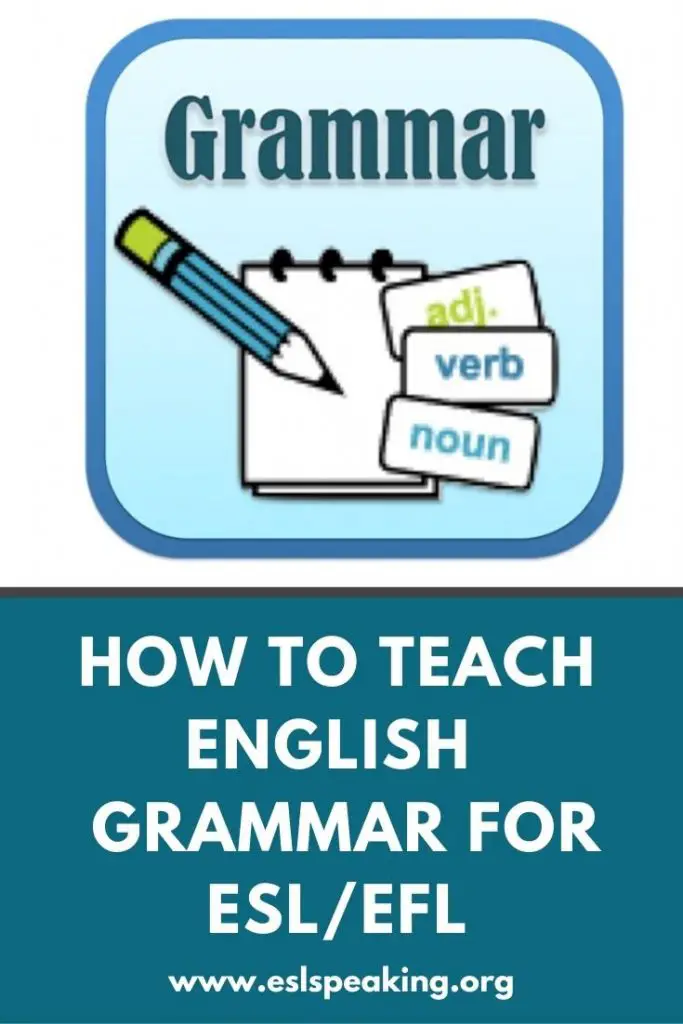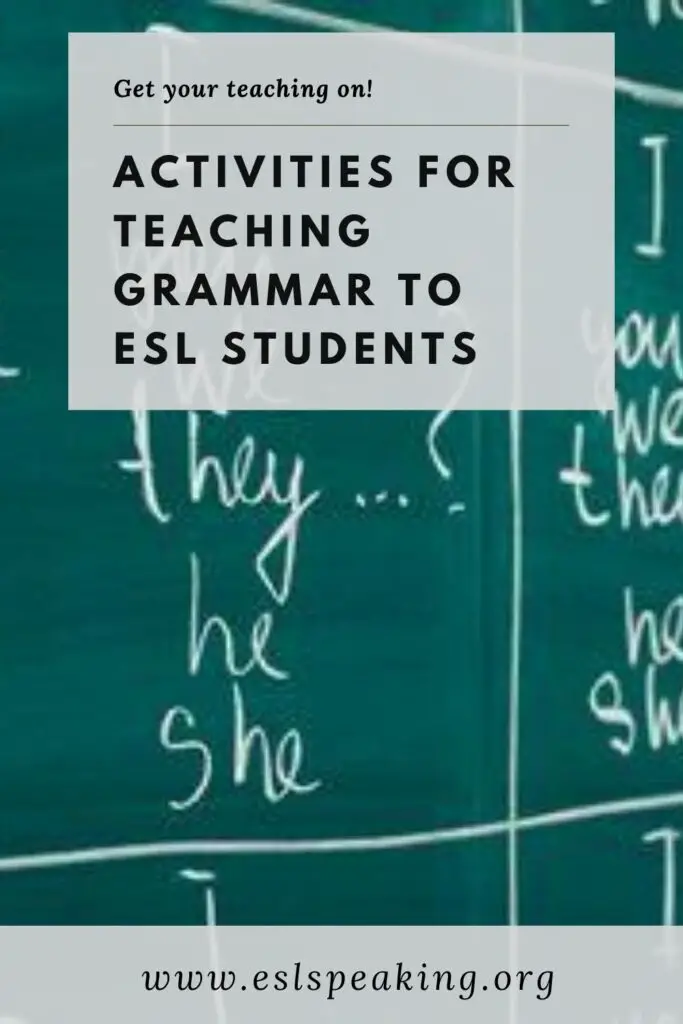Are you looking for a way to teach grammar that will engage your students and allow them to have fun?
Grammar lessons can be tricky for a variety of reasons. They can be boring. The grammar might be too challenging for the students. The teacher sometimes feels overwhelmed when trying to present and explain all those complex rules.
And often, teachers don’t want to teach grammar lessons because they just don’t seem to be that much fun. The students have to sit quietly and listen to a lecture on the present perfect, for example, before they actually get to do anything. Keep on reading for everything you need to know about TEFL grammar lessons.

How to Teach English Grammar
How to Teach an ESL/EFL Grammar Lesson
So let’s look at a way to plan and teach a grammar lesson that is both effective and enjoyable. We’ll go step-by-step through a teaching process that will really involve your students in the lesson and help them understand the rules—without long, complicated explanations.
Stage 1: The Lead-in
Instead of saying, “today we’re going to learn some grammar,” start your lesson by getting students engaged in an interesting, relatable topic. Think about a situation in which the grammar you’re teaching is likely to occur, and get students thinking about that—not about the grammar itself just yet.
For example, for a lesson on the causative structure (to have something done), you might consider that it would be easy to use this structure when talking about rich people or celebrities, who can afford to have a lot of things done for them.
If you’re using a coursebook, you can also just use whatever topic is presented on the page. In order to get students involved, pose a direct question. For instance, you could say, “Who is your favourite celebrity and why?” Then let the students discuss their thoughts in pairs for a few minutes.
Stage 2: Present the Grammar
The key to introducing the grammar is that it should be in context. Instead of just saying, “Now we’re going to learn the causative,” you want to show students examples of the causative structure that are somehow related to what they discussed in the lead-in.
After the lead-in about celebrities, you could give the students a picture of someone famous, like David Beckham, along with several sentences about him written in the causative structure (it’s ok if you have to make these up!):
- David Beckham has his meals cooked for him by an special chef.
- He got his favorite suit made in Paris.
- He has his car washed every day.
In doing this, you’re presenting the grammar in a way that has meaning and relevance; the students can start to understand what the structure means and why it’s used, because they can relate it to a real-life topic they were just discussing.

How to Teach ESL Grammar
Stage 3: “Teach” the Grammar
Your goal is to for students to be able to use this grammatical structure. And in order to do that, students need to be taught the meaning, form, and pronunciation of the structure. For many teachers, this is where the lecture starts. They think it’s their job to tell the students all of this information. If you’re not careful, this stage can turn into a long, teacher-fronted ramble that the students struggle to follow. Looking for a better way?
- Amazon Kindle Edition
- Bolen, Jackie (Author)
- English (Publication Language)
- 211 Pages - 12/21/2022 (Publication Date)
Try a Guided Discovery for Teaching Grammar
A guided discovery is a worksheet or activity that helps students understand a particular grammar structure. It’s ideal if students already know a little bit of information about the grammar points. For example, with the simple present.
The magic of a guided discovery is that it prompts the students to figure out the rules on their own, instead of being spoon-fed the information by the teacher. This means the students will be more engaged, more empowered, and ultimately more invested during the learning process. Here’s how a guided discovery works:
Use the same context and examples from earlier in the lesson. In this lesson about the causative, for instance, you would use the photo and sentences about David Beckham. Put these at the top of your guided discovery worksheet so students have clear examples to use in their exploration of the structure.
Next, create leading questions and short exercises that help the students understand what the structure means, how it’s used, and how it’s formed.
Do you have an Example of a Guided Discovery for a TEFL Grammar Lesson?
Download an example guided discovery to see exactly how this works by clicking this link: https://teflhorizons.com/causative-lp-materials-download
Let students do the guided discovery worksheet in pairs or small groups so they can talk through the exercises together. Walk around and monitor as they do this, answering any questions that come up. Once students have finished working on the guided discovery in their pairs/ groups, go over the answers as a class. In doing this, you’re just confirming the answers that the students already figured out. They basically just taught themselves!
- Amazon Kindle Edition
- Bolen, Jackie (Author)
- English (Publication Language)
- 112 Pages - 10/24/2019 (Publication Date)
Stage 4: Practice the Target English Grammar
Now the students need a chance to practice what they’ve learned. Here are a couple of fun, interactive practice ideas for the causative structure:
Try out this Survey Activity
Have the students write two or three questions they would like to ask all of their classmates, using the causative structure. For example:
- How often do you get your hair cut? (more adverb of frequency activities here)
- If you could have your living room re-painted, what color would you choose?
- Would you rather have your house cleaned for you or your meals cooked for you?
Let the students choose what they want to ask. As they write their survey questions, monitor to help them and correct errors as needed. Then tell the students they need to collect data from all the other students on the questions they wrote. They should all get up and mingle, asking each other student in class their questions and recording the answers.
Consider a Gallery Walk
A gallery walk involves putting pictures or prompts around the room and letting students walk around discussing each one- just like in an art gallery! For this lesson on the causative, you could post pictures of famous people around the room, and let students go from picture to picture, speculating about what each celebrity has done for them.
By using these techniques, you’ve effectively helped students with the grammar, but you’ve made it engaging and interactive. Well done!
Try it out for yourself! You can download the full lesson plan, including the guided discovery exercise, here: https://teflhorizons.com/causative-lp-materials-download
I Want to Know More about Teaching English Grammar!
Check out this video for even more information about how to teach grammar for TEFL teachers. It’s grammar for English language teachers made easy.
TEFL Grammar Lessons Examples
If you want to check out some ready-made grammar lesson plans, then have a look at some of these resources:
ESL Grammar Lessons FAQs
There are a number of common questions that people about teaching grammar to ells. Here are the answers to some of the most popular ones.
How do you introduce a grammar lesson?
To introduce a grammar lesson, be sure to set the context first by using a reading or listening passage. The key is that students are introduced to how the grammar point is used in a natural way first so that they have an idea for how they can use the language themselves.
How do you teach grammar in interesting ways?
It’s possible to teach grammar is an interesting way by making sure to set the context at the beginning of the lesson. Then, use a variety of reading or listening passages and finally, finish off the grammar lesson with controlled and then free practice. Consider using a variety of activities like running dictation, surveys or board games.
Why is teaching ESL grammar so difficult?
Many teachers find that teaching ESL grammar is difficult because they lack experience in doing so, students have high expectations and possibly negative perceptions of the class. Compounding this problem is that native English speakers may not be familiar with the ins and outs of English grammar.
What is ESL grammar?
ESL grammar is different from native English speaker grammar. Similar to pronunciation, ELLs have a grammar accent in that the way they speak usually sounds different from a native speaker.
Steps in an ESL Grammar Lesson
About the Author: Shannon Felt
As a life-long lover of literature and grammar, Shannon soon found that teaching English was just as much fun as studying it. That realization sparked a career that has taken her from Addis Ababa to Budapest. She’s worked as a CELTA trainer for over five years and has been teaching English much longer than that. She loves talking grammar for English language teachers.
She co-hosts the weekly ELT podcast Expand Your Horizons and is the co-founder of teflhorizons.com, which provides resources and practical guidance for ESL teachers. When she’s not teaching, training, podcasting, or blogging, Shannon can often be found drinking Turkish coffee and enjoying a good novel.

Teaching grammar to ESL students
Have your Say about How to Teach Grammar
Do you have any tips for teaching English grammar to ESL or EFL students? Any exercises that you like to do, or resources to recommend to us? Leave a comment below and let us know. We’d love to hear from you.
Also be sure to give this article a share on Facebook, Pinterest, or Twitter. It’ll help other busy teachers, like yourself find this useful resource.
p.s. Are you looking for information about teaching conjunctions? Then you’ll want to check this out: Conjunction Activities.
Last update on 2025-06-20 / Affiliate links / Images from Amazon Product Advertising API







Thanks so much for all the tips about teaching English grammar. I needed a framework for how to do it and this was it!
You’re welcome. Happy that you found this grammar teaching guide useful.
Teaching English grammar lessons…I have to do it all the time and really appreciate this framework for lesson planning. I feel like it’s just made my life better. Thanks so much for this resource.
Teaching grammar at the higher level can be kind of tough which is why it’s nice to have a framework like this to fall back on.
Awesome guide to teaching English grammar! I’m doing a TEFL course right now and this was exactly what I was looking for to plan my next lesson.
I was just planning a lesson for a TEFL course and was a bit clueless as to the steps. This cleared everything up. Thanks so much!